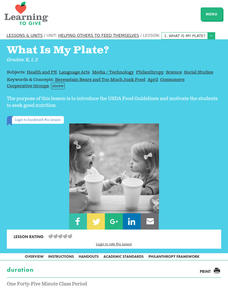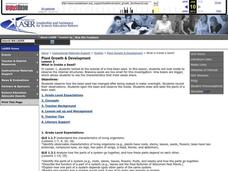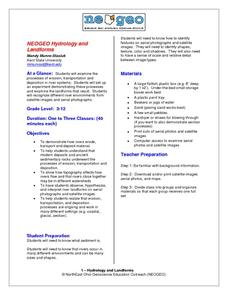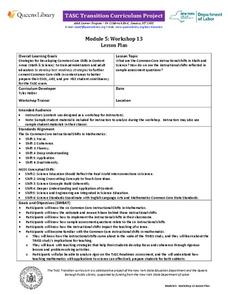CK-12 Foundation
Location on the Earth: Longitude and Latitude
To what degree do learners understand coordinates? Get them some practice in Yosemite National Park in a simple, fun interactive. Pupils explore a map and locate coordinates of popular sights within the park, then answer questions...
CK-12 Foundation
Latitude, Longitude, and Direction: Angle from the Equator
Which has the higher IQ, latitude or longitude? Longitude because it has 360 degrees! The interactive introduces the way latitude is measured and why it can never have more than 90 degrees. A handful of challenge questions encourage...
Virginia Department of Education
Planet Line-Ups
Should Pluto be considered a planet or a dwarf planet? Scholars research planets in our solar system to understand their similarities and differences. It also includes memory activities related to the order of the planets.
Achieve
Dairy Barn
Agriculture is truly a math-based profession! Help the dairy farmer determine the supplies needed to complete his barn. Using given dimensions, learners build equations and use units to determine the correct amount of materials.
Curated OER
What it means to be a scientist and What is the Scientific Process?
Students read an article and describe the scientific method. In this scientific process lesson, students compare basic science and applied science. Students discuss ideas such as team work, application of an idea, how scientists...
Curated OER
What is Everything Made of?
Students observe a demonstration on how we see space between water molecules. In this experimental lesson students discover what elements make up the things around them and discuss what they learned.
Curated OER
What is the Underlying Causality of a Simple Circuit?
Young scholars explore simple circuitry. They compare four models of circuits and explain how each works. Students contrast the cyclic cequential and cyclic simultaneous models using a shower curtain illustration and software simulation.
Curated OER
What Is an Egg Without its Shell?
Young scholars observe osmosis, a cellular process that normally can't be observed without a microscope, and use scientific method to observe osmosis in a chicken egg.
Curated OER
What Is Engineering Design
Students investigate the concepts related to the practice of designing and building large scale buildings. They conduct research using the internet and other resources in order to apply mathematics and architectural design principals in...
Curated OER
What is it? Sally Smells!
Students explore the attributes of the human nose. In this 5 senses lesson plan, students participate in a smell guessing game prior to discussing the anatomy of the nose and creating a sense of smell book page.
Curated OER
What Is the Food Pyramid?
Students are introduced to the USDA Food Pyramid. They discuss good nutrition and work cooperatively with the class to assemble a food pyramid puzzle.
Curated OER
What Is It? Tommy Tastes
Pupils complete multi-curricular to learn about senses and sensory words. In this sensory words instructional activity, students discuss the five senses and the anatomy of a tongue. Pupils complete a food tasting activity and find...
Curated OER
What is a Dry Forest?
Students explore the importance of the dry forest. In this science lesson, students discuss the history of dry forests and changes that have occurred due to human interaction. Students create a map showing the historical range of the dry...
Curated OER
What Is Mining
Student develop a vocabulary of "mining words" and study about exploring and mining for minerals. They break into groups and are assigned an area at the "mine" to do their "exploration" for the valuable "coal". The coal is represented...
Curated OER
What is Inside a Seed?
Students observe how the bean seed has changed after being soaked in water overnight and record their observations. They open the bean and observe the inside. Finally, students draw and label the parts of a bean seed and write the...
Curated OER
What is a Mammal?--1
In this Internet activity page worksheet, students investigate mammals by first doing research on the Internet. Students go to the suggested website, then answer the 10 questions on the page.
NorthEast Ohio Geoscience Education Outreach
Hydrology and Landforms
Three days of erosion exploration await your elementary geologists. Learners begin by examining rivers via Google Earth, then they model water flow in sand, and finally, they identify resulting landforms. This lesson is written...
Curated OER
Properties of Matter
This PowerPoint is a gem! Seventy-eight slides present an entire introduction to matter in bullet-point fashion. Viewers learn about everything from mass and inertia to phase changes and gas laws! The only glitch is that the links to...
Curated OER
An Introduction to GPS
GPS is a technological tool that has become available for use by the general public. Navigate the components and science involved in this remote sensing system. Here is a comprehensive collection of slides that would be valuable to share...
New York State Education Department
TASC Transition Curriculum: Workshop 13
The six instructional shifts in this workshop definitely move math and science teachers' understanding of instruction. The workshop, 13th out of a series of 15, asks participants to examine sample tests and to look at how the six...
Curated OER
Watershed Works: Unit 3
Geology whizzes observe the effects of change within a model of a watershed. They place replica waste dumps within the models and note the path that the waste takes as water passes through. This detailed lesson plan provides teacher...
Curated OER
Not Everyone Lived in Castles During the Middle Ages
Students complete a variety of online activities surrounding their study of the Middle Ages. They focus on the various levels of the class sytem and then role play a member of a given class.
iCivics
Step Five: All about Public Policy
Public policy is important to understand because it affects everyone. The resource tells middle schoolers how the government uses policy to accomplish goals in the administration. It includes a reading, true or false worksheet, a...
NOAA
Plate Tectonics Interactive
Here is a plate tectonics interactive that will really move your class! The first of a 13-part series introduces young geologists to the fundamental concepts and vocabulary they need to understand the interactions between...























